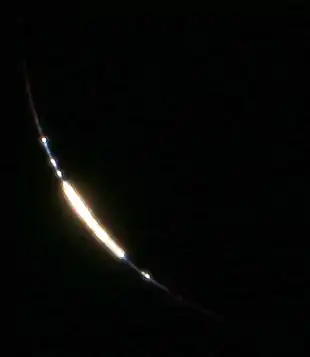Francis Baily
Francis Baily (28 April 1774 – 30 August 1844) was an English astronomer. He is most famous for his observations of "Baily's beads" during a total eclipse of the Sun. Baily was also a major figure in the early history of the Royal Astronomical Society, as one of the founders and as the president four times.
Francis Baily | |
|---|---|
.jpg.webp) Royal Astronomical Society portrait | |
| Born | 28 April 1774 Newbury, Berkshire, England |
| Died | 30 August 1844 (aged 70) London, England |
| Resting place | St Mary's Church in Thatcham |
| Known for | Baily's beads President of the Royal Astronomical Society |
| Awards | Gold Medal of the Royal Astronomical Society (1827 & 1843) |
| Scientific career | |
| Fields | Astronomy |
Life
Baily was born at Newbury in Berkshire in 1774 to Richard Baily.[1] After a tour in the unsettled parts of North America in 1796–1797, his journal of which was edited by Augustus De Morgan in 1856, Baily entered the London Stock Exchange in 1799. The successive publication of Tables for the Purchasing and Renewing of Leases (1802), of The Doctrine of Interest and Annuities (1808), and The Doctrine of Life-Annuities and Assurances (1810), earned him a high reputation as a writer on life-contingencies; he amassed a fortune through diligence and integrity and retired from business in 1825, to devote himself wholly to astronomy.[2]
Astronomical work

By 1820, Baily had already taken a leading part in the foundation of the Royal Astronomical Society,[3] and he received its Gold Medal in 1827[4] for his preparation of the Society's Catalogue of 2881 stars (Memoirs R. Astr. Soc. ii.).[2] Later, in 1843, he would win the Gold Medal again.[4] He was elected as President of the Royal Astronomical Society four times, with two-year terms each (1825–27, 1833–35, 1837–39 and 1843–45).[3][5] No other person has served in the position more than Baily's four times (a record he shares with George Airy), whilst his eight years in the post are a record.[5]
The reform of the Nautical Almanac in 1829 was set on foot by his protests. He was elected a Foreign Honorary Member of the American Academy of Arts and Sciences in 1832.[6] He recommended to the British Association in 1837, and in great part executed, the reduction of Joseph de Lalande's and Nicolas de Lacaille's catalogues containing about 57,000 stars; he superintended the compilation of the British Association's Catalogue of 8377 stars (published 1845);[7] and revised the catalogues of Tobias Mayer, Ptolemy, Ulugh Beg, Tycho Brahe, Edmund Halley and Hevelius (Memoirs R. Astr. Soc. iv, xiii.).[2]
His observations of "Baily's Beads", during an annular eclipse of the sun on 15 May 1836, at Inch Bonney in Roxburghshire, started the modern series of eclipse expeditions. The phenomenon, which depends upon the irregular shape of the moon's limb, was so vividly described by him as to attract an unprecedented amount of attention to the total eclipse of 8 July 1842, observed by Baily himself at Pavia.[2]

In other work, he completed and discussed H. Foster's pendulum experiments, deducing from them an ellipticity for the Earth of 1/289.48 (Memoirs R. Astr. Soc. vii.). This value was corrected for the length of the seconds-pendulum by introducing a neglected element of reduction, and was used, in 1843, in the reconstruction of the standards of length. His laborious operations for determining the mean density of the Earth, carried out by Henry Cavendish's method (1838–1842), yielded the authoritative value of 5.66.[2]
Baily died in London on 30 August 1844 and was buried in the family vault in St Mary's Church in Thatcham, Berkshire. His Account of the Rev. John Flamsteed (1835) is of fundamental importance to the scientific history of that time. It included a republication of the British Catalogue.[2]
The lunar crater Baily was named in his honour, as was the rigid and thermally insensitive alloy used to cast the 1855 standard yard (Baily's metal, 16 parts copper, 2.5 parts tin, 1 part zinc), and a local primary school in the town of Thatcham (Francis Baily CofE Primary School).
References
- Hockey, Thomas (2007). The Biographical Encyclopedia of Astronomers. Springer Publishing. p. 8. doi:10.1007/978-0-387-30400-7_99. ISBN 978-0-387-30400-7. Retrieved 31 August 2021.
- One or more of the preceding sentences incorporates text from a publication now in the public domain: Chisholm, Hugh, ed. (1911). "Baily, Francis". Encyclopædia Britannica. Vol. 3 (11th ed.). Cambridge University Press. p. 221. This also cites
- J. Herschel's Memoir of F. Baily, Esq. (1845), also prefixed to Baily's Journal of a Tour, with a list of his writings (see Further reading).
- Month. Not. R. Astr. Soc. xiv. 1844.
- Dreyer, John L. E.; Turner, Herbert H. (1923). History of the Royal Astronomical Society, 1820–1920. Vol. 1. London: Royal Astronomical Society.
- "Gold Medal Winners" (PDF). RAS. 2014. Archived from the original (PDF) on 24 September 2015. Retrieved 9 January 2015.
- "List of Presidents and Dates of Office". A brief history of the RAS. Royal Astronomical Society. Retrieved 10 September 2012.
- "Book of Members, 1780–2010: Chapter B" (PDF). American Academy of Arts and Sciences. Retrieved 5 May 2011.
- Ridpath, Ian. "Francis Baily and the British Association Catalogue".
Further reading
- Dieke, Sally H. (1970). "Baily, Francis". Dictionary of Scientific Biography. Vol. 1. New York: Charles Scribner's Sons. pp. 402–403. ISBN 0-684-10114-9.
- Herschel, John (1844). "Memoir of the late Francis Baily". Monthly Notices of the Royal Astronomical Society. 6: 89–121. Bibcode:1844MNRAS...6...89.. doi:10.1093/mnras/6.10.89.
- Higgitt, Rebekah (March 2004). "Astronomers against Newton". Endeavour (published March 2004). 28 (1): 20–24. doi:10.1016/j.endeavour.2004.01.012. PMID 15036924.